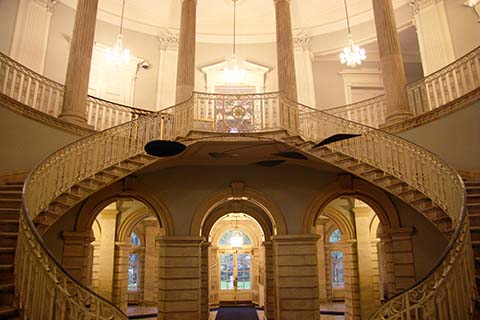
 Department of Citywide Administrative Services311
Department of Citywide Administrative Services311 Search all NYC.gov websites
Search all NYC.gov websites
City Hall

New York, NY 10007
Date Built: 1803-1811
Architect: Joseph Francois Mangin and John McComb, Jr.
"…one of the most beautiful early 19th century public buildings in the United States."
-- NYC Landmarks Preservation Commission
City Hall has been the seat of New York City government since 1812. Located in City Hall Park at the southern end of the Civic Center, City Hall is one of the most treasured buildings in the City.
In the 17th century, the Dutch City Hall was in the old City Tavern on Pearl Street. A new City Hall was built in 1700 at Wall and Nassau Streets. It was renamed Federal Hall when New York became the first capital of the United States. The 1833-1842 Federal Hall National Memorial is now on this site. The Common Council talked about a new City Hall as early as 1776 but the Revolutionary War intervened. A site was chosen, the old Common at the northern limits of the City, now City Hall Park.
In 1802, a competition was held for the new City Hall and twenty-six proposals were submitted. First prize of $350 was awarded to John McComb, Jr. and Joseph Francois Mangin. John McComb's father repaired the old City Hall in 1784. John McComb, Jr. was a New Yorker while Joseph Mangin was trained in his native France. McComb designed the landmark Hamilton Grange on Convent Avenue, Castel Clinton in Battery Park and the James Watson House on State Street. Joseph Mangin was City Surveyor in 1795 and published an official City map with Casimir Goerck in 1803. He designed the landmark Old St. Patrick's Church on Mott Street. City Hall is the only known project the two architects collaborated on together.
Construction was delayed until 1803 due to objections by the Common Council that the design was too expensive. The size of the building was reduced and brownstone was used on the rear to keep costs down. Construction moved slowly due to labor disputes and a Yellow Fever outbreak. Workmen earned one to one and one half dollars a day. The building was dedicated in 1811 but did not open until 1812.
The architectural style of City Hall is a combination of two famous historical movements. The exterior facade reflects that of the French Renaissance, and the interior that of the American-Georgian style. The building consists of a central pavilion with two projecting wings. The design of City Hall influenced at least two later civic structures, the Tweed Courthouse and the Surrogate's Courthouse. The entrance, reached by a long flight of steps, has figured prominently in civic events for over a century and a half. There is a columned entrance portico capped by a balustrade, and another balustrade at the roof. The domed tower in the center was rebuilt in 1917 after the last of two major fires. The original deteriorated Massachusetts marble facade, with brownstone on the rear, was completely reclad with Alabama limestone above a Missouri granite base in 1954-6.
On the inside, the rotunda is a soaring space with a grand marble stairway rising up to the second floor, where ten fluted Corinthian columns support the coffered dome. The rotunda has been the site of municipal as well as national events. Abraham Lincoln and Ulysses S. Grant were laid in state here, attracting enormous crowds to pay their respects. City Hall is a designated New York City Landmark. It is also listed on the New York State and National Registers of Historic Places.


